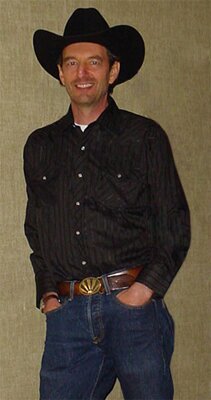Welcome to the “My Place” page
 My name is Scott My name is Scott
I run the Rope and Wire website.
My original idea for this page was to give those living in the country the opportunity to tell others about the things that made their farm or ranch so special.
Well, I’ve come to the conclusion that either no one likes to brag or no one lives on a farm or a ranch. Whatever the case, no one submitted an article so I felt it was high time to try something different.
So for now this will be literally “My Place.” I’ll use this page to post a western blog or short articles. They will either be mine, or possibly one from a contributing R&W community member.
The theme will remain Western but the content will change weekly, or there about.
If you click on any of the links to past blog's, you can return to this page by clicking on the My Place button across from my picture.
I hope you enjoy it but if not, might I suggest you “stroll the grounds.” Read a story or watch a movie.
Thanks for visiting.
Scott
Cowboys…way out West
When I mention cowboys and cattle, what part of the country comes to mind? Texas or maybe Arizona? Cattle country for sure and the American cowboy has been around these parts for well over 100 years. But did you know there is a state even further West that has been the home to cattle ranching and cowboys for even longer than that? And I’m not talking California.
What could be further West than California you say? Well, how about Hawaii.
No, I’m not crazy. It’s true. There are both cowboys and cattle ranches in Hawaii. In fact cowboys and cattle ranching have been at home in Hawaii for 175 years. Long before the white man gave a whole lot of thought about venturing West of the Mississippi.
History tells us there have been longhorn cattle in Hawaii since 1793. They were a gift from England to the King of Hawaii. The King was so impressed with the longhorns he placed them under “sacred” protection and they were allowed to roam and breed freely for many years. But, as the old saying goes, all good things must come to an end.
Within twenty years the cattle had grown so numerous and unmanageable the sacred protection was lifted and life for the once protected Hawaiian cow was changed forever. Some of the cattle were hunted for sport and others were rounded up into herds.
So the question is, what came first, the cow or the cowboy? Well, in Hawaii, it was obviously the cow.
The Hawaiians really didn’t know what to do with the longhorns once they had rounded them up. They had no experience in the cattle ranching business. So in 1832 the King of Hawaii sent an ambassador to Mexico for some much needed help in managing this new herd.
The ambassador returned with three Spanish-Mexican “Vaqueros”. The native Hawaiians trained by these South of the border cowboys soon became known as “Paniolos”. That’s “Hawaiian cowboys” to us mainlanders.
The Vaqueros were so skilled in their craft and the King was so impressed with their abilities he requested more Vaqueros be sent to Hawaii to teach the Hawaiians how to ranch. The Vaqueros not only taught the Hawaiians how to handle cattle, they also taught them their crafts such as how to work with leather and metal. They became skilled in making saddles, lariats and bullwhips as well as bits and spurs.
Not only did the Paniolos take on new and valuable skills, they also took on the colorful dress of the Vaqueros, and do so to this very day.
By the 1830’s cattle ranching had become a very successful and intricate part of the Hawaiian economy. Cattle hides and beef were exported to an international market. In fact, Hawaiian beef was shipped to the mainland during the California gold rush.
You know, I find it interesting that Hawaii has such a rich heritage in the cattle industry and that the “Paniolos” have excelled at the necessary skills needed to manage cattle. But, if compared to the Western cowboy of the continental United States, the similarities end there. There’s something very unique about the cowboy of the old West and when you put the two saddle to saddle, they are worlds apart.
|